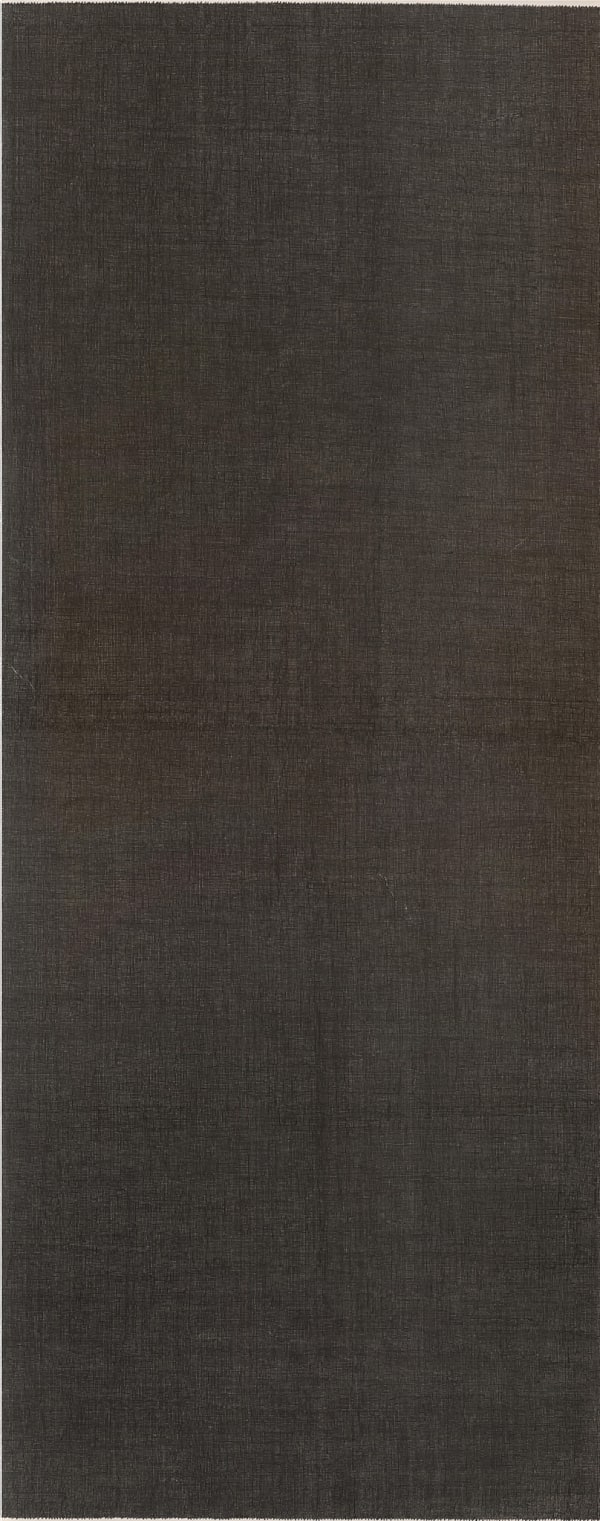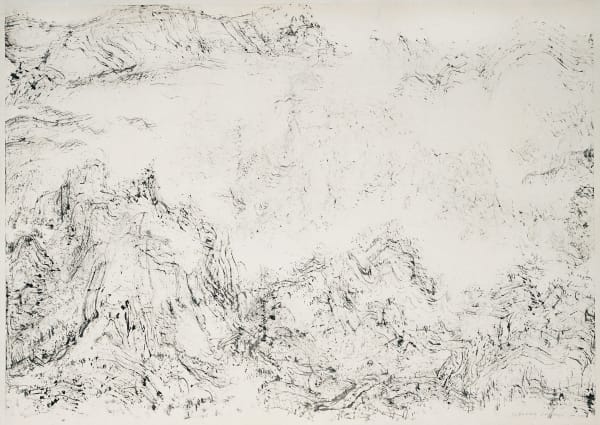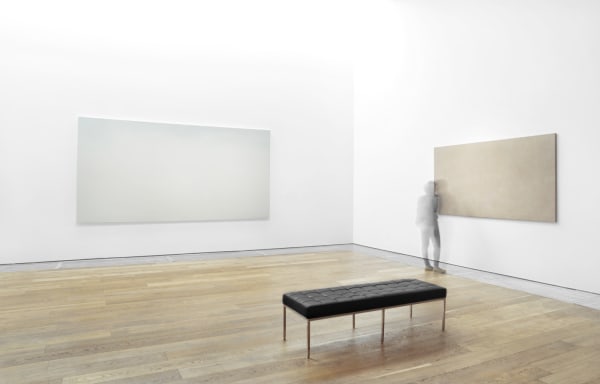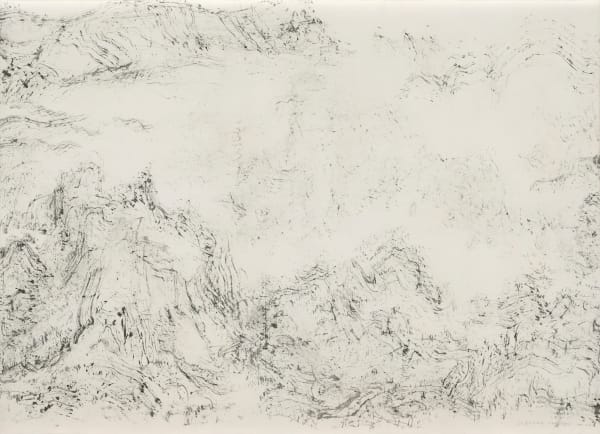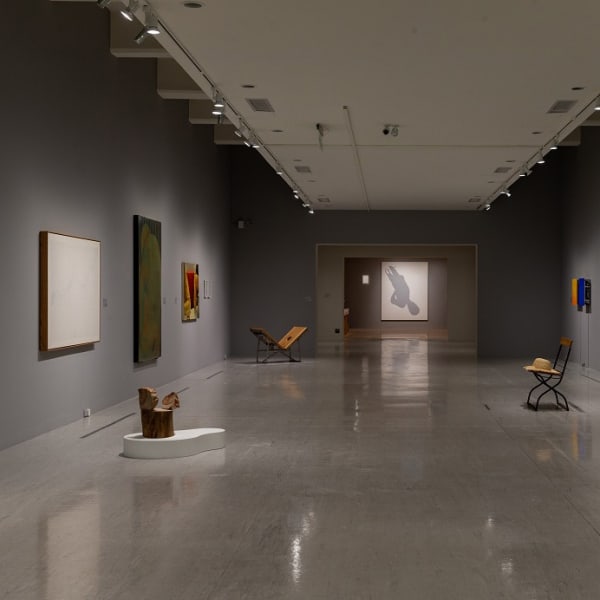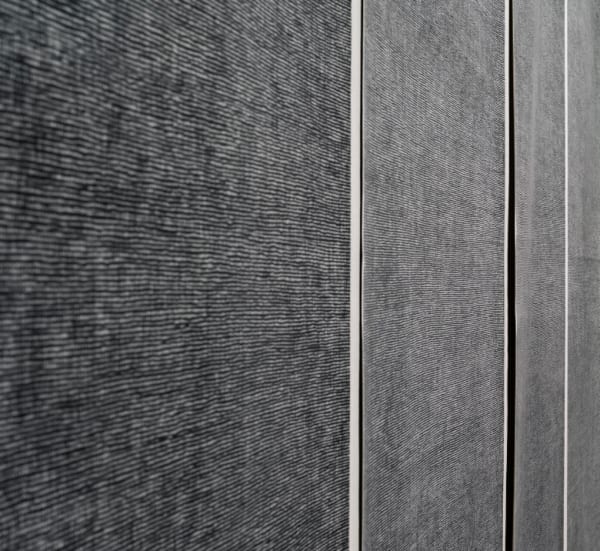b. 1944 in Yibin, Sichuan province, lived and worked in Chengdu, Sichuan Province.
d. 2018 in Chengdu.
Li Huasheng was a classically-trained ink painter who explored the shared phenomenology between mind-hand embodiment in classical brush and ink practice in calligraphy and landscape painting and time- and process-based practices employed in contemporary art. Li's practice includes processual grid paintings, abstract ink landscapes, photography and ink-and-paper-based installations.
Before embarking on his exploration of processual abstraction, Li Huasheng was widely recognized one of the pre-eminent traditional landscape artists of his generation and was featured in a national exhibition of China's ten leading contemporary artists at the National Art Museum of China, Beijing (1981), the Contemporary Chinese Painting exhibition that toured eight museums across the United States (1983-1985), and the seminal exhibition Tradition and Innovation that traveled to the Hong Kong Museum of Art, Singapore Art Museum, the British Museum, London, and the Museum für Ostasiatische Kunst Köln, Germany (1995). During this time, Li also traveled outside of China where he held solo exhibitions at Harvard University, Yale University, University of Michigan, and University of Washington (1987) and at the National Museum of Singapore (1992).
Li Huasheng described his travels in the United States as liberating. Unable to speak English, he was free to experience life unencumbered by the social, cultural and historical expectations that accompanied his status as one of China's most highly acclaimed living landscape artists. When Li returned from the US, he no longer felt able to paint landscapes in the traditional manner as he had before. Living now as a reclusive, he departed on seasonal excursions into the Himalayas-Chinese landscape artists had never addressed these mountains as a subject and he felt drawn to their remoteness. During his travels, Li frequently stayed overnight in Tibetan Buddhist monasteries and woke, in the early hours, to the rhythmic sounds of the resident monks chanting their morning prayers. It then occurred to him that the way he would paint the Himalayas was not by depicting their outward form but by recording his state of mind while living amidst the mountains themselves.
By 1998, this insight had led Li Huasheng to develop an entirely novel, unprecedented practice as an ink artist: while in a disciplined, meditative state, Li hand-limns vast grids of horizontal and vertical lines. Each hand-brushed line —like an embodied EKG of his being in time— captures and records the moment-by-moment phenomenological state of his body, perceptions, feelings, emotions and thoughts. Holding the brush as only a painter trained through decades of practice is able, Li deployed each line in a state of meditative concentration, so that any minor fluctuations are directly attributable to fluctuations in qi, or the vital energy of his body and mind. This practice has occupied him for over a decade.
Since the year 2000, when they drew international notice at the Shanghai Biennale, Li Huasheng's grid paintings have been an essential feature of almost every major exhibition of Chinese contemporary ink painting, particularly abstract ink painting. Li's grids have been featured twice at the Shanghai Biennale (2000, 2002), the Guangdong Museum of Art (2001), the First Chinese Art Triennial Exhibition at the Guangzhou Art Museum (2002), the National Art Museum of China in Beijing (2003, 2013); the International Ink Painting Biennale at the Shenzhen Art Museum (2004, 2008), the Shenzhen Fine Art Institute (2005); the Shanghai Art Museum (2005); the China Millennium Monument in Beijing (2006), the Shanghai Doulun Museum of Modern Art (2006, 2009); the Chengdu Biennale at the Museum of Contemporary Art Chengdu (2007, 2023), the OCT Contemporary Art Terminal of the He Xiangning Art Museum in Shenzhen (2007, 2013), and the Today Art Museum in Beijing (2007, 2009, 2011); Ink Narrative at the Yokohama Art Project in Yokohama, Japan (2007); Form, Idea, Essence and Rhythm at the Taipei Fine Arts Museum (2008); and Ink Art: Past as Present in Contemporary China at the Metropolitan Museum of Art in New York (2013); The Weight of Lightness: Ink Art at M+ in Hong Kong (2017), and Ink Dreams: Selections from the Fondation INK Collection at LACMA in Los Angeles (2021); Walking the Crack at Taipei Fine Arts Museum in Taiwan (2022); Symphony of All the Changes —The 7th Guangzhou Triennial in Guangdong (2023); Translations: Afro-Asian Poetics at the Institutum in Singapore (2024).
International curators and critics such as Gao Minglu have recognized the importance of Li's processual practice and featured his grid paintings in seminal exhibits such as Chinese Maximalism at the China Millennium Monument in Beijing and the UB Anderson Gallery at University at Buffalo in New York (2003); Prayer Beads and Brush Strokes at Beijing Tokyo Art Projects, Beijing (2003); Yi Pai: Thirty Years of Chinese Abstraction at the Wall Museum in Beijing and La CaixaForum Palma de Mallorca, Barcelona, and Madrid, Spain (2008); Yi Pai at the Today Art Museum in Beijing (2009); Ink and Paper-Exhibition of Contemporary Chinese Art at the Guangdong Museum of Art and the Kunsthalle in Weimar, Germany (2005); Korean-Chinese Contemporary Ink Painting at the Seoul Museum of Art, South Korea (2005).
For Process, Mind and Landscape –November 29, 2014 through January 31, 2015– Ink Studio Artistic Director, Britta Erickson, has curated a solo retrospective that surveys Li Huasheng's artistic practice since his 1998 break with tradition. The exhibition includes a wide selection of Li's signature processual grids that reveal rich and subtle variations developed within this long-standing series; a focused selection of Li's rarely-exhibited, highly-abstract ink landscapes created contemporaneously with his processual grids; and a new series of works that unites Li's grids with the his explorations of gestural abstraction in both landscape painting and calligraphy. Exhibited works include a singular, monumental set of iconic grid paintings –0699 (five panels each 365 x 148 cm)– and a special meditation room where visitors can spend an extended amount of time immersed in the experience of Li's process.
Li Huasheng's works can be found in the permanent collections of the National Art Museum of China, Beijing, the Metropolitan Museum of Art, New York, the British Museum, London, the Chicago Art Institute, Chicago, M+ Museum, Hong Kong, the Shanghai Art Museum, Shanghai, the Guangdong Museum of Art, Guangzhou, the He Xiangning Art Museum-OCT Contemporary Art Terminal, Shenzhen, and the permanent art collections of Harvard University, Yale University, University of Washington and University of Michigan. His works are currently on display at the Metropolitan Museum of Art and Los Angeles County Museum of Art, and will be shown at the Guangdong Museum of Art in March 2018.
Li Huasheng's traditional landscape painting is the subject of a monograph by Jerome Silbergeld, P.Y. and Kinmay W. Tang Professor of Chinese Art History at Princeton University, Contradictions: Artistic Life, the Socialist State, and the Chinese Painter Li Huasheng (1993) and his artistic practice since Silbergeld's ground-breaking study is the subject of the forthcoming monograph, Li Huasheng: Process, Mind and Landscape, edited by Britta Erickson and distributed internationally by D.A.P. Li Huasheng was also the subject of the documentary film "Li Huasheng's Ambivalence," in the series The Enduring Passion of Ink, directed by Britta Erickson and filmed by Richard Widmer.
-

Taipei | Contemporary Ink, Global context
Bingyi, Jeong Gwang Hee, Li Huasheng, Jennifer Wen Ma, Wang Tiande, Yang Jiechang, Zheng Chonbin 18 - 24 Oct 2023Virtual Exhibition INKstudio is delighted to present the exhibition 'Global Ink, Contemporary Contexts' in Taipei. INKstudio selected seven artists based in various regions across continents, including Western Europe, the United...Read more -

Global INK: INKstudio’s Ten Year Anniversary Exhibition
Bingyi, Chen Haiyan, Huang Chih-yang, Li Jin, Li Huasheng, Liu Dan, Peng Kang-long, Wang Dongling, Wang Tiande, Xu Bing, Yang Jiechang, Zheng Chongbin 17 Jun - 29 Jul 2023The current exhibition, Global INK, is our opportunity to share with everyone what we have discovered over our first decade of programming. It is not a group show but instead a special exhibition consisting of twelve separate solo presentations by twelve artists who we believe define the new global contemporary INK.Read more -

Painting the Heart-Mind: The Art of Inoue Yūichi and Li Huasheng
5 Jun - 1 Aug 2021INKstudio, Beijing, Shibunkaku, Kyoto, and the Li Huasheng Art Foundation are co-organizing a dual artist exhibition of modern calligraphies by post-war, Japanese calligrapher Inoue Yūichi(1916–1985) and abstract paintings by post-Cultural Revolution literati ink painter Li Huasheng(1944–2018).Read more -

Luminous Shadows
18 Nov 2017 - 19 Jan 2018The group exhibition Luminous Shadows explores spirituality and transcendence in the sensory engagement with the material world, recuperating dimensions of art repressed by a modern aesthetics of detached contemplation. The work of art is here ritualized anew as a vehicle for salvation and awakening, a self-conscious theatrical illusion, a sensuous body of pleasure and pain, and an object of pious devotion and yearning.Read more -

Ink and the Mind
Ink and phenomenology. Exhibition No.2 19 Mar - 12 May 2016Ink and the Mind explores the myriad connections between ink painting and cognition, perception, affect, and imagination.Read more -

PROCESS, MIND, AND LANDSCAPE
LI HUASHENG 29 Nov 2014 - 31 Jan 2015Li Huasheng: Process, Mind, and LandscapeRead more
-

Li Huasheng, Yang Jiechang, He Yunchang at Mingyuan Museum of Art
November 4, 2023Getting Righteousness and Formlessness -- Abstract Narratives of Instantaneous Perception Date: 11.5, 2023-1.28, 2024 Curator: Zhang Yu Academic Chair: Gao Minglu Venue: Shanghai Mingyuan Museum...Read more -

Li Huasheng at ART TAIPEI 2023
Mastering Ink October 13, 2023ART ASSETS X ESG - MASTERING INK Date: 2023, 10.20-23 Venue: Taipei World Trade Center Exhibition Hall 1 'ART TAIPEI' is celebrating its 30th anniversary...Read more -

Time Gravity - 2023 Chengdu Biennale|He Yunchang, Li Huasheng, Wang Dongling, Wang Tiande, Xu Bing, Yang Jiechang, Zheng Chongbin
August 12, 2023Time Gravity - 2023 Chengdu Biennale Date: July 16–November, 2023 Venue: Area A and B of Chengdu Art Museum in Tianfu Art Park, Chengdu (Chengdu...Read more -

Exhibition | Li Huasheng at Taipei Fine Arts Museum
November 15, 2022Walking the Crack 2022.09.08-2023.01.08 Taipei Fine Arts Museum Walking creates paths, which may be shortcuts or perhaps detours. A path may start from tracking others...Read more -

INKstudio at West Bund 2021
Jeong Gwang Hee, Lee In, Li Huasheng, Wang Dongling, Wang Tiande November 6, 2021BOOTH A212 11-14. 11, 2021 West Bund Art Center, Building A INKstudio will explore INK as the basis for an international contemporary art rooted in...Read more -

Exhibition | CHINA NOW: NEW LITERATI ART (New York's Asia Week)
March 1, 2017INK studio, the critically-acclaimed Beijing-based art gallery, is pleased to announce China Now: New Literati Art , its inaugural group exhibition in the United States....Read more -

Exhibition | Iconic work by Li Huasheng on view at Los Angeles County Museum of Art
January 19, 2017Li Huasheng's monumental ensemble grid painting 0669 (2006) is on loan to the Los Angeles County Museum of Art. Three of its four panels are...Read more -

INK studio Booth One of "20 Best" at Art Basel Hong Kong 2016
March 25, 2016Our solo presentation of Li Huasheng's grid paintings and abstract landscapes at Art Basel Hong Kong has generated a lot of buzz and been widely...Read more -

Art Fair | Li Huasheng at Art Basel Hong Kong
February 15, 2016At Art Basel | Hong Kong 2016, INK studio will present a selection of representative works from the current practice of Li Huasheng (b. 1944...Read more -

EXHIBITION | JING SHEN: THE ACT OF PAINTING IN CONTEMPORARY CHINA
July 9, 2015Two paintings by Li Huasheng, along with works by 19 other Chinese artists from three different generations, are on view in the exhibition 'Jing Shen:...Read more
-

2023 Gallery Weekend Beijing | Global INK: INKstudio’s Ten Year Anniversary Exhibition
June 30, 2023Read more -
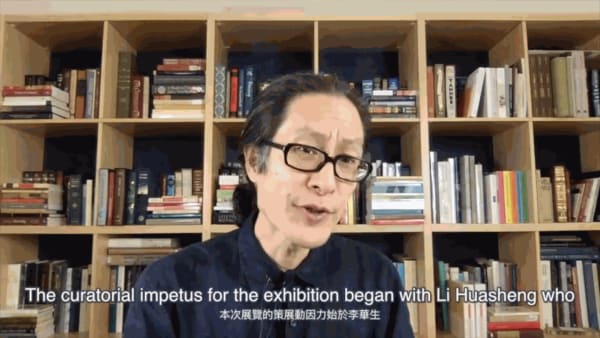
The INKstudio's director Craig Yee talking about the exhibition " PAINTING THE HEART-MIND: THE ART OF INOUE YŪICHI AND LI HUASHENG"
July 3, 2021Read more -

Gao Minglu talking about Li Huasheng
June 15, 2021Read more -

The Enduring Passion for Ink: A Project on Contemporary Ink Painters
Britta Erickson February 7, 2017The Enduring Passion for Ink: A Project on Contemporary Ink Painters (or the 'Project') is a proposed exhibition, book, and film series designed to introduce...Read more -

Reality is not worthy of love
August 4, 2016Read more



